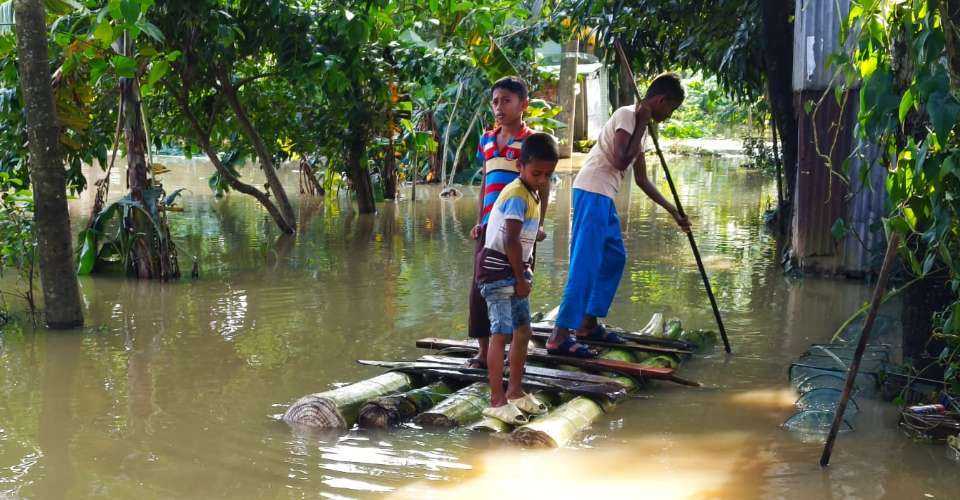
Children use a raft made from banana trees to travel in a village in Moulvibazar district of northeast Bangladesh on June 20. (Photo supplied)
Bidya Sagar became terrified when he found cracks had appeared on the mud walls of his thatched house in northeastern Bangladesh following heavy monsoon downpours last week.
The two-room house is the only place to call home for the 50-year-old Hindu tea worker and his five-member family on top of a small hill at the Rashidpur tea estate in Habiganj district.
The house narrowly survived an impending collapse but the crops — rice and vegetables — on Sagar’s two acres of land were destroyed.
Tens of thousands of people like Sagar are suffering such losses all over the northeast region.
“Crops are all dead by now,” Sagar told UCA News. He leased out the land to a local farmer for 20,000 taka (US$170) per annum to tackle a financial crisis. He fears not getting this year’s payment due to the loss of the crops.
Sagar, who earns about 1,000 taka from working in the tea estate, is worried about how to maintain the family once the flooding is over.
Habiganj, a part of Bangladesh’s Haor Basin covering six districts in the northeast, is among four districts where heavy rain and an onrush of floodwater from upstream India marooned millions of people.
The Sylhet Divisional office, covering the four districts of Sylhet, Moulvibazar, Sunamganj and Habiganj, said the latest flooding affected about five million people.
Haor is a unique, low-lying and bowl-shaped wetland and part of a natural ecosystem found in northeast Bangladesh. Haors are connected to various rivers and become vast water bodies during the rainy season fed by monsoon rain and flash floodwater from the Indian hills.
During the winter and summer farmers cultivate various crops including rice, the staple food in Bangladesh.
Flooding in the Haor Basin has been an annual affair for years. However, extreme and long-lasting flooding in recent years has been blamed on climate change impacts as well as encroachment, pollution and the silting of vital rivers in the region.
Flooding in Sylhet district lasted for nearly two weeks, devasting lives and livelihoods, government officials said.
At least 70,000 people were left homeless and lost many domestic animals and birds including cattle and chickens. The government opened 1,700 flood shelters for the homeless people.
Local sources say many people failed to take long, treacherous journeys to flood evacuation centers due to a lack of transportation, like boats, and were left stranded.
The flooding began on June 14 following record rainfall in various places in the hilly Indian state of Meghalaya. The state’s wettest village Mawsynram received 640 millimeters of rain on June 15, and 780 millimeters three days later, according to the Indian Meteorological Department.
Meanwhile, districts in Sylhet recorded 300-433 mm rainfall during that period.
The floodwater coming down from the Indian hills washed away everything in its path, including houses, giant trees, cattle, fish enclosures and standing crops.
The Sylhet divisional office of the Department of Agricultural Extension (DAE) estimated that the flooding swamped 26,000 hectares of cropland.
“Thousands of farmers in the affected areas missed the time to cultivate Aus this year,” said Motiuzzaman, deputy director of DAE.
Aus is one of the three varieties of paddy rice cultivated in Bangladesh. Aus rice is planted between March and April and harvested by June-July.
The divisional fisheries office estimated that 23,813 fish farms were swept away in the flooding that lasted for 11 days.
“Such deluges were not very common during our childhood,” said Shah Alam, 40, a Muslim and vegetable vendor, told UCA News.
Flood-affected Alam has been living with his relatives in Juri, a sub-district of Moulvibazar.
While Alam lamented his loss of daily income of 500 taka due to flooding, he is even more saddened by the loss of 35 chickens and three goats.
Unfortunately, the flooding also hit households on June 17, the day of Eid-ul-Adha, the second most important Islamic festival when Muslims slaughter and share millions of sacrificial animals.
Alam said flooding is not just intense but also lingering.
“Flash floods used to last for hours, not more than a day or two in the worst-case scenario,” said Alam.
Another devastating flood in 2022 hit the Sylhet region when it was engulfed by floodwater for a week and left at least six million people stranded.
That year, the government deployed soldiers for rescue operations using helicopters and boats.
In 2017, an early flood in March hit Haor districts, destroying rice fields worth 130 billion taka.
AKM Saiful Islam, who teaches flood and water management at the state-run Bangladesh University of Engineering and Technology, said that climate change impacts were indeed intensifying flash floods.
The Intergovernmental Panel on Climate Change (IPCC) has already warned about incidents of flooding being compounded because of heavy precipitation and sea level rise. The IPCC particularly warned about precipitation intensity associated with tropical cyclones.
This first of this year’s flooding was triggered on May 30 after the cyclonic storm Remal dumped massive amounts of rain for days after making landfall on May 28. Parts of Sylhet city and over half of Sylhet district remained underwater for days.
The divisional office of the Bangladesh Water Development Board (BWDB) said that 1,200mm of rainfall in Cherrapunji of Meghalaya and 747mm of rainfall in Bangladesh’s Jaflong city had triggered the first flash flood.
A meeting held on June 2 at the Sylhet divisional commissioner’s office discussed the inadequacy of basic logistics such as life jackets and boats to conduct emergency rescue during such a deluge.
The first wave of flash floods affected a million people, including 44,000 farmers. It washed away 8,820 fisheries, according to official estimates.
One of the reasons behind floods lingering is the loss of the navigability of the rivers, say BWDB officials.
The rivers could not be dredged properly as machines failed to work due to strewn polythene on the riverbeds, they said.


